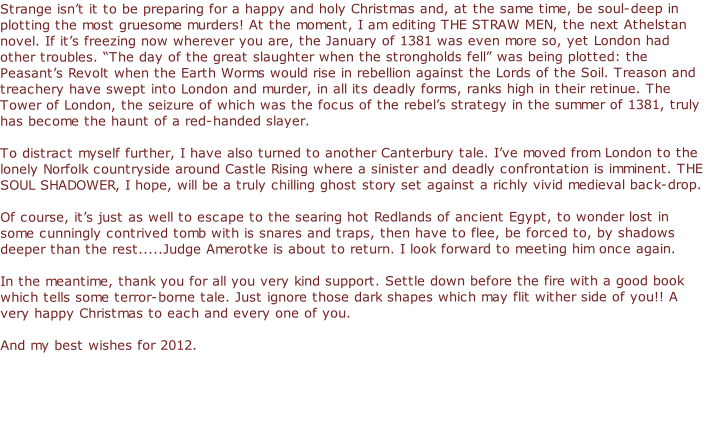THE MIDNIGHT MAN has now just been published. I am very pleased with it; I just hope you readers agree! I do think the medieval era lends itself to both the Gothic and the Ghoulish as well as providing a marvellous stage on which to develop a complex murder mystery. I am also working on the final draft of my novel about the last days of Henry VIII (THE LAST OF DAYS). I have studied this monster time and again, he can still surprise me! In 1513 James IV was killed at Flodden; his corpse was found by Henry’s commander, Surrey, and brought to London after being embalmed at Berwick. However, probably because he was excommunicated, James’s corpse was never buried but kept in a cellar right up into the reign of Elizabeth I. Apparently some workmen found it and played football with the head. Eventually it was given some form of Christian burial in a London church.
Nevertheless, if Henry was bad, those who surrounded him, e.g. the Dudleys and the Seymours, were no better. They do remind me of the Mafioso: they have that same combination of superficial religion and deep psychopathic tendencies. Indeed this is my view of many of the nobility at the time which, hopefully, I will explore in greater depth in my planned novel on the War of the Roses. I don’t think this idea is far-fetched. When I was studying for my doctorate at Oxford, I remember getting into constant trouble because I had developed such a theory! Nevertheless, the facts speak for themselves, nor do I think it was just the nobles. It is surprising how quickly certain powerful London merchants could whistle up their gangs, the “rifflers”, the “roaring boys”, the “squires of the sewers”, to create mayhem and murder. Gangland bosses may be a 20th century term, but they were certainly alive and well and flourishing most murderously in the 15th century. Prime examples are the Woodvilles. The voluptuous Elizabeth Woodville ensnared Edward IV into marriage and this immediately brought her family into confrontation with the factions and gangs of her husband’s two brothers, George of Clarence and Richard of Gloucester. I look forward to developing this in the very near future in a suitably murderous medieval way!
Kindest regards to you,
Paul Doherty OBE



 BLOODSTONE is about to hit the shops. I am really pleased Athelstan is back, he has to investigate grisly gruesome murders against a vivid backdrop of London in the freezing winter of 1380. Athelstan was living in dangerous times; England was moving, not towards a clash between the great barons, but those who called themselves the Earthworms, the poor, the marginalised. A few months later, the entire southeast of England erupted into revolt. Athelstan will, one day, have to make choices about what side he is on. I’m currently finishing another in that series, THE STRAW MEN; this is mainly based in the Tower. I thoroughly enjoyed doing the research on this and came across a most interesting entry. Apparently, the Royal Menagerie was kept there; this included lions and leopards, gifts to the King from rulers in the Middle East. However, one gift must have surprised Londoners (as well as the elephant), a gift from the king of Norway, a huge polar bear which was allowed to swim in the moat! Naturally, the bear makes an appearance in THE STRAW MEN!
BLOODSTONE is about to hit the shops. I am really pleased Athelstan is back, he has to investigate grisly gruesome murders against a vivid backdrop of London in the freezing winter of 1380. Athelstan was living in dangerous times; England was moving, not towards a clash between the great barons, but those who called themselves the Earthworms, the poor, the marginalised. A few months later, the entire southeast of England erupted into revolt. Athelstan will, one day, have to make choices about what side he is on. I’m currently finishing another in that series, THE STRAW MEN; this is mainly based in the Tower. I thoroughly enjoyed doing the research on this and came across a most interesting entry. Apparently, the Royal Menagerie was kept there; this included lions and leopards, gifts to the King from rulers in the Middle East. However, one gift must have surprised Londoners (as well as the elephant), a gift from the king of Norway, a huge polar bear which was allowed to swim in the moat! Naturally, the bear makes an appearance in THE STRAW MEN!